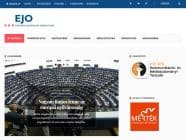More and more online news outlets are experimenting now with paywalls, but academic research on the subject is still in its its infancy. A new study by Merja Myllylahti (Auckland University of Technology, New Zealand) published in Digital Journalism tries to narrow this gap in knowledge. It considers the impact of different paywall models on revenue of media corporations in the United States, the United Kingdom, Finland, Slovakia, Slovenia, Poland, Australia, and New Zealand. The EJO carried out a similar overview.
Myllylahti’s analysis included nine cases: The New York Times Group/The New York Times (USA); Pearson Group/Financial Times (UK); Piano Media (Slovakia, Slovenia, Poland); News Corporation/The Times and The Sunday Times (UK); News Limited/The Australian (Australia); Fairfax/Australian Financial Review (Australia); National Business Review (New Zealand); Sanoma Group/Helsingin Sanomat (Finland); and Alma Media/Kauppalehti (Finland).
One of the reasons for little research is the fact that paywalls are relatively new phenomenon. So far academic interest has focused on estimating the willingness of readers to pay for online news content and the general consensus is that there is very little motivation to pay for news. The author quoted previous studies, which argue that, the audience does not consider general online news as having a “unique value” and is unlikely to be the basis of an economically viable business model. At the same time, readers are sometimes willing to pay for online news if they would believe there is a real threat to the news provider’s survival.
The study has defined a paywall as a “system that prevents internet users from accessing webpage content without paid subscription” and separates “content that one has to pay for from the rest of the content on the net.” It distinguished four types of paywalls:
- hard/full paywalls – no access to content without subscription;
- soft paywalls – some free content
- metered paywalls – restricts number of free articles;
- freemium paywalls – some free content, charges for premium content.
Paywalls have developed rapidly since 2012 as the news industry tries to cope with the financial pressures of digital era. News organizations are losing advertisement and print subscription revenue. Their digital platforms are not able to offset the losses made in print. The study points out that “every one dollar gained in digital advertising has resulted in loss of seven dollars in print.”
The findings of the study indicate that the digital-only subscriptions represent approximately 10 percent of the news companies total circulation/publication revenues. The type of paywall did not seem to significantly affect its revenue levels. For instance, the metered paywall of the NYTimes.com secured some 7.2 percent of company’s total circulation revenue. For The Times, which has a hard paywall, the number was approximately 8.9 percent.
The study also found that financial newspapers charge more for their online content than general newspapers. In case of Financial Times, the paywall revenue fraction was higher too – 13 percent of total circulation revenue. This is expected: financial newpapers have a large number of corporate clients, and offer niche content at a premium price.
There was also some evidence of paywall prices erosion. The Australian Financial Review and the New York Times have been decreasing the price of digital subscription to increase their readership.
The case of Piano Media offered an interesting example of a nationwide paywall: the company provides publishers with paid content systems. It was adopted by 25 media groups in Slovakia, Slovenia, and Poland and offers users the content package from few providers for a monthly fee. The revenue is split between publishing partners and the company. The findings show that the model requires high volumes of readers to generate substantial revenue.
In general, the study suggests that paywalls create additional income for news corporations, but they still do not offer a viable business model in short term. To attract more readers, online editions are forced to lower the price of access to online news content, but this will eventually erode their digital revenues. And while some newspapers claim the paying segment of their online audience is growing, their experience contradicts previously conducted research. In the United States, the researchers have found that readers prefer print editions and are reluctant to pay for digital news.
One of the problems highlighted in the paper is that paywalls are penetrable and increasingly softening. For example, many articles are accessible through the search engines or web links shared on social networks. Furthermore, the newspapers often dropped the paywalls during major events such as Hurricane Sandy in the US or 2012 Olympics in the UK. The effects is somewhat paradoxical. Although the newspapers fail to monetize their product during the peaks in readers’ interest, making news available for free increases the number of page visits and drives up the advertisement income.
One important consideration is that audience behavior is expected to be different in different countries: a subject that invites further investigation.
Another problem that arose during the research is general lack of transparency about the actual state of paywalls and revenue they generate on the part of news organizations. It left the author of research wondering: Why are publishers hiding their numbers if the paywalls are as successful as they seem to suggest?
Source: Newspaper paywalls – the hype and the reality. A study of how paid news content impacts on media corporation revenues by Merja Myllylahti (Digital Journalism, 2014).
Photo credit: Tax Credits / Flickr Cc
Tags: Alma Media, Auckland University of Technology, Financial Times, Journalism, media business models, Media economics, Media research, Merja Myllyhalti, National Business Review, New York Times, paywall, Paywalls, The Times













































